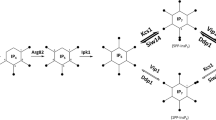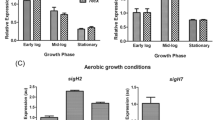Abstract
YLR162W is an uncharacterized Saccharomyces cerevisiae ORF whose transcript level is elevated in cells under environmental stress, during α-factor response and in stationary phase. We obtained a partial cDNA clone of YLR162W by subtractive hybridization cloning of genes that were not expressed in a CoCl2 resistant DNA synthesis mutant but expressed in its wild type counterpart. Our studies demonstrated that YLR162W transcript level was reduced in BY4741 cells upon exposure to the hypoxia mimetic agent CoCl2, and continuous expression of full length YLR162W from a plasmid borne copy of the gene rendered BY4741 cells extremely susceptible to the hypoxic conditions induced by CoCl2. At initial time points following the induction of YLR162W expression, cell cycle progression was inhibited with the emergence of a distinct sub-G1 peak indicative of apoptotic cells, mitochondrial membrane potential was also decreased along with an increase in the fraction of cells permeable to propidium iodide; none of the above was further affected by CoCl2. The up-regulation of Ylr162wp in cells exposed to environmental stress and in non-replicating cells appears to be related to its growth inhibitory properties presented in this report.




Similar content being viewed by others
References
Klein P, Kanehisa M, DeLisi C (1985) The detection and classification of membrane-spanning proteins. Biochim Biophys Acta 815:468–476
Von Heijne G, Gavel Y (1988) Topogenic signals in integral membrane proteins. Eur J Biochem 174:671–678
Stephens C, Harrison SJ, Kazan K, Smith FWN, Goulter KC, Maclean DJ, Manners JM (2005) Altered fungal sensitivity to a plant antimicrobial peptide through over-expression of yeast cDNAs. Curr Genet 47:194–201
Shcherbakova PV, Hall MC, Lewis MC, Bennett SE, Martin KJ, Bushel PR, Afshari CA, Kunkel TA (2001) Inactivation of DNA mismatch repair by increased expression of yeast MLH1. Mol Cell Biol 21:940–951
Matsuoka H, Suzuki Y, Iwahashi H, Arao T, Suzuki Y, Tamura K (2005) The biological effects of high-pressure on the yeast transcriptome. Braz J Med Biol Res 38:1267–1272
Wiesenberger G, Steinleitner K, Malli R, Graier WF, Vormann J, Schweyen RJ, Stadler JA (2007) Mg2+ deprivation elicits rapid Ca2+ uptake and activates Ca2+/calceneurin signaling in Saccharomyces cerevisiae. Eukaryot Cell 6:592–599
Roberts CJ, Nelson B, Marton MJ, Stoughton R, Meyer MR, Bennett HA, He YD, Dai H, Walker WL, Hughes TR, Tyers M, Boone C, Friend SH (2000) Signaling and circuitry of multiple MAPK pathways revealed by a matrix of global gene expression profiles. Science 287:873–880
Gasch AP, Spellman PT, Kao CM, Carmel-Harel O, Eisen MB, Storz G, Botstein D, Brown PO (2000) Genomic expression programs in the response of yeast cells to environmental changes. Mol Biol Cell 11:4241–4257
Lai LC, Kosorukoff AL, Burke PV, Kwast KE (2006) Metabolic-state-dependent remodeling of the transcriptome in response to anoxia and subsequent reoxygenation in Saccharomyces cerevisiae. Eukaryotic Cell 5:1468–1489
Kwast KE, Lai L-C, Menda N, James DT III, Aref S, Burke PV (2002) Genomic analyses of anaerobically induced genes in Saccharomyces cerevisiae: functional roles of Rox1 and other factors in mediating the anoxic response. J Bacteriol 184:250–265
Wang GL, Semenza GL (1995) Purification and characterization of hypoxia inducible factor 1. J Biol Chem 270:1230–1237
Sambrook J, Fritsch EF, Maniatis T (1989) Molecular cloning: a laboratory manual. CSHL Press, NewYork
Diatchenko L, Lau Y-FC, Campbell AP, Chenchik A, Moqadm F, Huang B, Lukyanov S, Lukyanov K, Gurskaya N, Sverdlot E, Siebert PD (1996) Suppression subtractive hybridization: a method for generating differentially regulated or tissue-specific cDNA probes and libraries. Proc Natl Acad Sci USA 93:6025–6030
Lee S-J, Schwartz MF, Duong JK, Stern DF (2003) Rad53 phosphorylation sites clusters are important for Rad53 regulation and signaling. Mol Cell Biol 23:6300–6314
MacKAY VJ, Mal B, Waters L, Breeden LL (2001) Early cell cycle box-mediated transcription of CLN3 and SWI4 contributes to the proper timing of the G1-to-S transition in budding yeast. Mol Cell Biol 21:4140–4148
Ludovico P, Sousa MJ, Silva MT, Leao C, Côrte-Real M (2001) Saccharomyces cerevisiae commits to a programmed cell death process in response to acetic acid. Microbiology 147:2409–2415
Kajstura M, Halicka DH, Pryjma J, Darzynkiewicz Z (2007) Discontinuous fragmentation of nuclear DNA during apoptosis revealed by discrete ‘‘Sub-G1’’ peaks on DNA content histograms. Cytometry Part A 71A:125–131
Nargund AM, Avery SV, Houghton JF (2008) Cadmium induces a heterogeneous and caspase-dependent apoptotic response in Saccharomyces cerevisiae. Apoptosis 13:811–821
Elledge SJ (1996) Cell cycle checkpoints: preventing an identity crisis. Science 274:1664–1672
Burhans WC, Weinberger M, Marchetti MA, Ramachandran L, D’Urso G, Huberman JA (2003) Apoptosis-like yeast cell death in response to DNA damage and replication defects. Mutat Res 532:227–243
Acknowledgments
We are grateful to Dr. G. Ilavazhagan Director, DIPAS, for his support during the course of this work. We acknowledge Ms. S. Parmar’s (a former summer trainee in the laboratory) work in isolating the CoCl2 resistant DNA synthesis mutants. The work was supported by the Ministry of Defence, Govt. of India. NK was supported by a fellowship from DRDO, Min. of Defence, Govt. of India.
Author information
Authors and Affiliations
Corresponding author
Rights and permissions
About this article
Cite this article
Kumar, N., Meena, R.C. & Chakrabarti, A. Over-Expression of YLR162W in Saccharomyces cerevisiae Inhibits Cell Proliferation and Renders Cells Susceptible to the Hypoxic Conditions Induced by Cobalt Chloride. Indian J Microbiol 51, 206–211 (2011). https://doi.org/10.1007/s12088-011-0132-3
Received:
Accepted:
Published:
Issue Date:
DOI: https://doi.org/10.1007/s12088-011-0132-3




